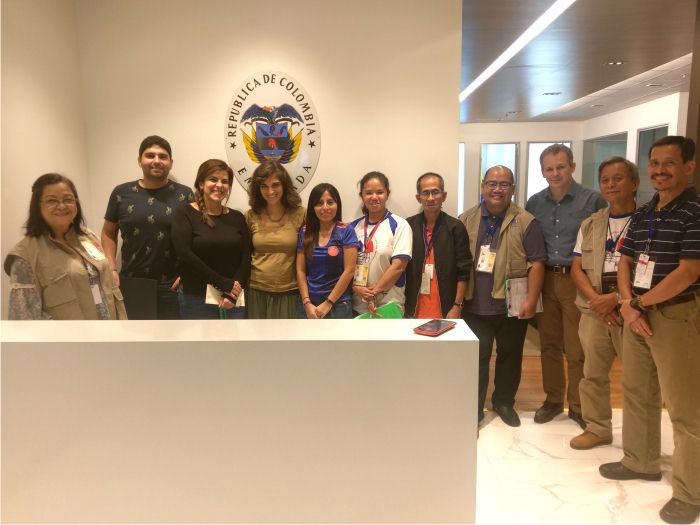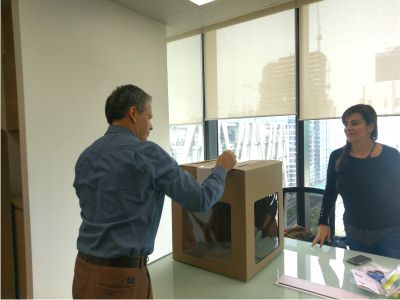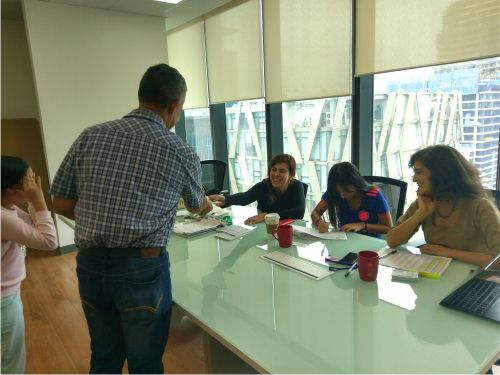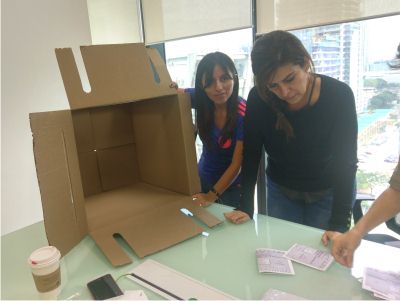|
|
| |
NAMFREL volunteers observed overseas voting in
connection with the second round of the Colombian presidential election,
on June 17 at the Colombian Embassy in Manila. NAMFREL took part in the
observation, in support of the call for observers by the Global Network
for Domestic Election Monitors (GNDEM), to participate in the worldwide
monitoring organized by Colombia's Misión de Observación Electoral
(MOE). The individual volunteers received accreditation from Colombia's
Consejo Nacional Electoral (CNE) through the efforts of the MOE. The
overseas voting at the embassy was facilitated by His Excellency Victor
Hugo Echeverri Jaramillo, Colombian Ambassador to the Philippines, the
embassy staff, and volunteer Colombian poll jurors (polling station
workers) residing in the Philippines. In Colombia, serving as a poll
juror is compulsory, electronically and randomly selected by national
identification numbers.
. |
| |
 |
| |
It was the third time for NAMFREL volunteers
to observe Colombian overseas voting. Volunteers first observed the
second round of the Colombian presidential election on June 15, 2014.
They also observed the Colombian peace agreement referendum on October
2, 2016.
Overseas voting lasted for a week, starting on June 11. Each day, the
embassy received voters who registered to take part in the overseas
voting. The embassy requested the participation of volunteers to serve
as poll jurors -- at least three volunteers per day -- from among the
Colombians who are residing in the Philippines. At the end of each day,
the votes received for that day were counted, and the results were
transmitted electronically to Colombia. The process started anew the
following day, using accountable forms for that specific day.
Consolidation of total votes received at the embassy for the 7-day
voting period was done in Colombia, not at the embassy.
It was the third election this year for Colombians. Parliamentary
elections were held on March 11, while the first round of the
Presidential elections was held on May 27.
There are two main institutions in charge of elections in Colombia: the
Consejo Nacional Electoral (CNE) is the policy-making body in-charge of
general oversight of the electoral process, including the accreditation
of parties and observers, as well as declaration of winners, among other
functions, while the Registraduría Nacional del Estado Civil (National
Civil Registry) is tasked with the logistics of the actual carrying out
of the elections, including the registration of voters and selection of
poll jurors, among other functions.
|
| |
Voting process
Colombia used a hybrid election system for the presidential
elections, in which voters manually filled out ballots, while
the results were both transmitted electronically to Bogota, and
also manually verified. Election tallies were made available on
a website, and the result of the election based on electronic
transmissions was known on the night of election day.
For the second round of voting for president, voters were
presented with one ballot containing three choices: Candidate A
with running-mate, Candidate B with running-mate, and a third
option that says "Voto en Blanco," which essentially means "none
of the above," an official abstention or vote of disapproval of
the two options, which was also tallied along with the votes
garnered by the two candidates. |
.. |

|
|
| |
 |
.. |
(The Voto en Blanco option was
also present in the ballot for the first round, which had six
presidential candidate teams to choose from.) In the Colombian
election system, a majority win for Voto en Blanco could prompt
the holding of another election for the position being contested
with a different set of candidates.
After receiving the ballot, voters then went behind a voting
booth to write an X mark over the photo of their chosen
candidate team. Voters can only mark one option. Marking two or
more options spoils the ballot.
After marking the ballot, voters returned to the desk where the
poll jurors were seated, and were then made to drop their ballot
inside the ballot box. Like the voting booth, the ballot box was
made of cardboard. It was sealed by a specially-marked adhesive
tape. |
.
Before leaving the polling station, instead of being marked with
indelible ink on a finger, voters were given a "Certificado
electoral," a numbered card that proves that the voter has
voted. This card comes with benefits, as it can be redeemed for
discounts and other advantages in procuring government services.
In the second round of voting observed in Manila, the whole
process inside the polling station, from the looking up of name
on the voter list, until the handing out of the certificado
electoral, took less than a minute for some voters. |
|
.. |
|
| |
 |
... |
Counting, consolidation,
and transmission
During the counting of votes in the embassy, the ballots were
first sorted according to candidate voted, in this case, into
two, for Candidate A and Candidate B. Nobody marked the space
for Voto en Blanco.
The results of the voting were then written by the poll jurors
on a form called E-14, the Acta de Escrutinio de los Jurados de
Votación, or simply, the record of the count or tally form. The
E-14 was torn into three parts, separated by perforation after
the number of votes were written on it; they looked like
receipts after they were perforated. Each part contained blanks
where the number of votes garnered were written by hand, and all
were signed by the poll jurors. |
|
| |
While all parts of the E-14 tally form should
contain identical data, each part has a different purpose:
| . |

|
The first part is used to show the
results at the polling station. It has no legal value. |
| |

|
The second part of the E-14 will
be submitted physically to the Scrutinizing Committee upon
reaching Colombia, for manual verification of results, checking
the results indicated on this part against the results that were
transmitted electronically. This part of the E-14 is the
document used in consolidating the official results at various
levels, becoming the basis for the proclamation of the winners.
In Colombia, this form is handed immediately after the count, to
members of the Scrutinizing Committee present at the polling
station. The Committee is made up of judges, public notaries,
and registrars. |
| |

|
The third part of the E-14 is
given to the designated personnel who will encode the results on
a computer and transmit the results electronically to Bogota.
The results from this form are shown on a website so that the
public can track the results, down to the polling station level. |
|
| |
.
Each part of the E-14 had identical bar codes, but unique QR
codes. The embassy was required to send all the accountable
forms back to Colombia through DHL within two days after voting
ended.
The NAMFREL volunteers were allowed to observe the transmission
of the results of the voting for the day. The designated
personnel at the embassy was handed the part of the E-14 for
transmission. Using a VPN provided by the National Civil
Registry specifically for this purpose, the personnel connected
to the internet and logged on to the Civil Registry's website
(https://www.registraduria.gov.co/) using the office desktop
computer, to type the results. The website required that the
figures were entered three times to ensure accuracy. Aside from
the Civil Registry's website, the results were also accessible
through a mobile app that could be downloaded by the public for
free. |
.. |
 |
|
| |
.
The new president and vice president will assume office on August 7,
2018, with their term ending on August 7, 2022. They will not be allowed
to run for re-election. |
| |
|
|
|
| |
. |
| ...... |
|
|

